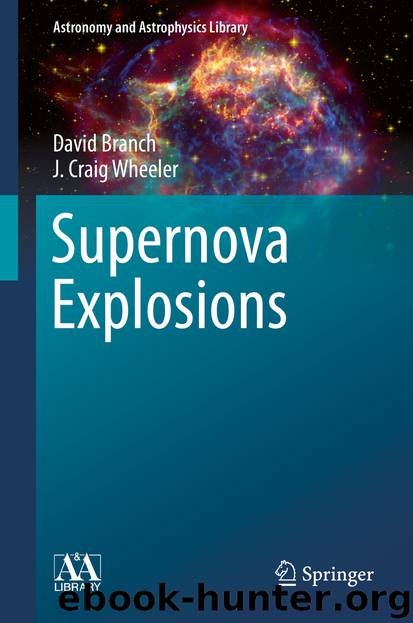Supernova Explosions by David Branch & J. Craig Wheeler

Author:David Branch & J. Craig Wheeler
Language: eng
Format: epub
Publisher: Springer Berlin Heidelberg, Berlin, Heidelberg
16.4.4 Models of Nebular-Phase Spectra
Following the hints that SN Ib/c come from massive stars, Chugai (1986) predicted strong [O I] λλ6300,6364 in the nebular phase of SN Ib, as was soon confirmed. Gaskell et al. (1986; see also Begelman and Sarazin (1986), who deduced 50 M⊙ of oxygen and a pair-instability progenitor for SN 1985F) argued from the strength of the [O I] λλ6300,6364 feature in the nebular-phase spectra that there was a major conflict between the ejecta mass derived from the width of the light-curve peak, a few M⊙, and from the [O I] line strengths, tens of M⊙. This was resolved by recognizing that the strength of the [O I] lines is quite sensitive to temperature, that the temperature varies through the oxygen-rich region of the ejecta, and that the important temperature-calibrating line of [O I] λ5577 is often blended and difficult to observe. The strengths of the [O I] lines are affected by mixing and deposition of decay products. These early models were spherically symmetric, and the mixing and deposition were done ad hoc. This needs to be reconsidered in the context of asymmetric models with plumes and jets.
The He I lines that define SN Ib become weaker in late phases when helium is not sufficiently excited by radioactive decay. Models of the Type IIb SN 1993J predict H and He I lines to be visible in the early nebular phase, until ∼ 100 days, but to disappear by ∼ 200 days. The lack of H lines in the early nebular phase of SN Ib complements their lack in the photospheric phase, suggesting that SN Ib contain substantially less than 0.1 M⊙ of hydrogen (Swartz et al. 1993a,b).
In the nebular phase, the flux ratio of [Ca II] λλ7291,7323 to [O I] λλ6300,6364 can be a diagnostic of the core mass of a progenitor star, with higher ratios indicative of lower-mass cores (Fransson and Chevalier 1987, 1989) because the mass of explosively synthesized calcium in the ejecta is not sensitive to the ZAMS mass, whereas the ejected mass of oxygen is. The Type Ib SN 1999dn had a rather low flux ratio, [CaII]/[OI] = 0.55, suggesting a progenitor of higher ZAMS mass than those of other stripped-envelope events (Benetti et al. 2011). SN 2009jf may have ejected an especially large amount of oxygen, ∼ 1 M⊙, implying a rather high-mass progenitor (Sahu et al. 2011). Note again that various techniques for estimating mass must be cross-checked for self-consistency. Care must also be taken when the oxygen lines show splitting and the calcium lines do not, since that suggests a different geometry and hence perhaps a different origin for the calcium, e.g., natal rather than freshly synthesized.
Download
This site does not store any files on its server. We only index and link to content provided by other sites. Please contact the content providers to delete copyright contents if any and email us, we'll remove relevant links or contents immediately.
Tools of Titans by Timothy Ferriss(7818)
Turbulence by E. J. Noyes(7704)
Astrophysics for People in a Hurry by Neil DeGrasse Tyson(5003)
Secrets of Antigravity Propulsion: Tesla, UFOs, and Classified Aerospace Technology by Ph.D. Paul A. Laviolette(4999)
Design of Trajectory Optimization Approach for Space Maneuver Vehicle Skip Entry Problems by Runqi Chai & Al Savvaris & Antonios Tsourdos & Senchun Chai(4845)
Room 212 by Kate Stewart(4741)
Pale Blue Dot by Carl Sagan(4621)
The David Icke Guide to the Global Conspiracy (and how to end it) by David Icke(4384)
A Journey Through Divination and Astronomy by Publishing Pottermore(4251)
Apollo 8 by Jeffrey Kluger(3514)
Goodbye Paradise(3452)
Losing the Nobel Prize by Brian Keating(3428)
COSMOS by Carl Sagan(3352)
The Five People You Meet in Heaven by Mitch Albom(3336)
Brief Answers to the Big Questions by Stephen Hawking(3242)
How to Read Water: Clues and Patterns from Puddles to the Sea (Natural Navigation) by Tristan Gooley(3241)
How to Read Nature by Tristan Gooley(3081)
The Order of Time by Carlo Rovelli(3075)
A Brief History of Time by Stephen Hawking(2821)
